This video illustrates how children at S.A.M are encouraged to solve word problems on Fractions logically using bar models
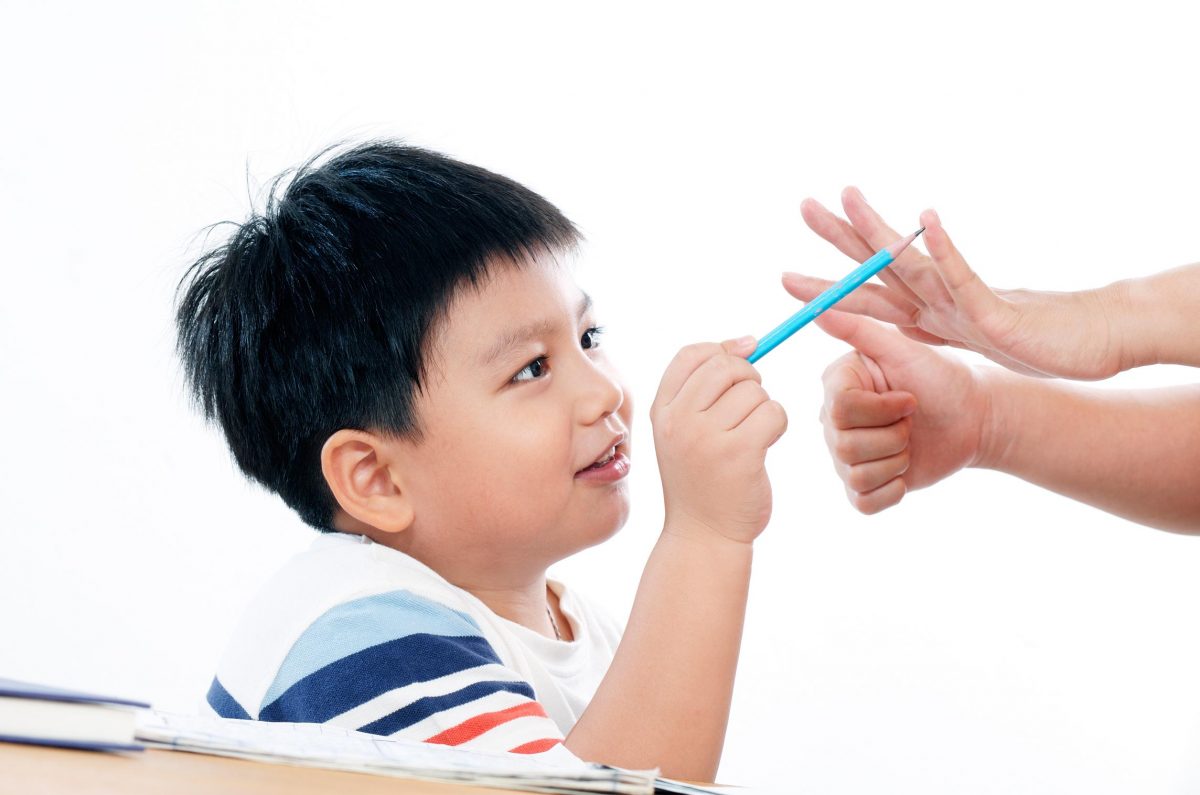
This video illustrates how children at S.A.M are encouraged to solve word problems on Fractions logically using bar models

Ever tried to help your child with primary math homework and got stumped? Today’s math questions can be challenging – even for adults.
Math education is changing. While many parents spent time memorising procedures and formulas, today’s students are expected to not only understand and master the concepts, but also to have strong thinking skills and problem-solving skills to solve complex math questions.
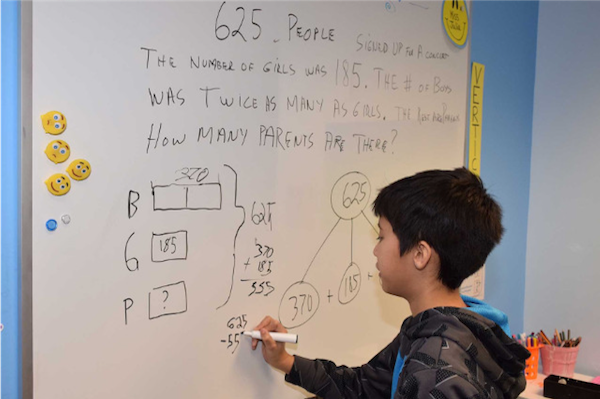
As new concepts and strategies are being taught, and homework turns from arithmetic exercises to using multiple ways to solve a math word problem, you may feel unsure or have no idea how to help your child.
In this series, the curriculum team at Seriously Addictive Mathematics (S.A.M) shares expert tips on math heuristics and how to use them to solve math word problems.
What are Math Heuristics?
Heuristics – a word that baffles many primary school students and their parents.
To define it simply, math heuristics are strategies that students can use to solve complex word problems.
Word problems can be solved in several ways using different heuristics, while some word problems are solved using a combination of heuristics.
To solve word problems efficiently, students must be familiar with both the problem-solving methods (heuristics) and the problem-solving process.
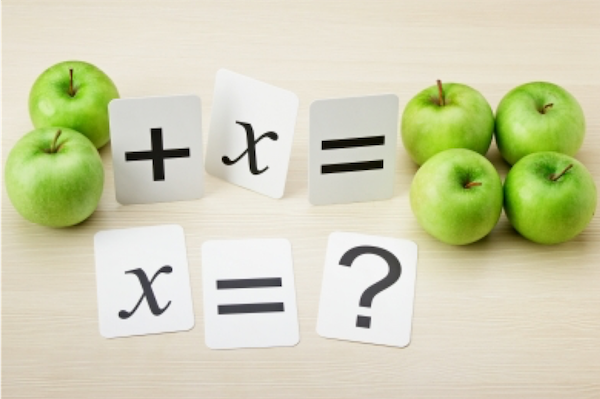



Do you find it challenging to get your children to learn Maths? Here are some useful secrets to help get them going:
1. Study Smart, Not Study Hard
Often, children may underperform in Maths when they have a poor grasp of the fundamental concepts. This might be due to that fact that they are learning Maths through rote memorisation and practice, without truly understanding the concepts or the problem-solving process.
Understanding concepts is very important. For example, 7 x 6 is 7 groups of 6 objects within each group. It is not just about memorising the multiplication table. Understanding the root concepts enables your children to figure out their own answers even if they forget the multiplication table.
Maths questions are usually non-routine nowadays, and they challenge your children’s minds in different ways. Remember – the process is more important than the product.
2. Demonstrate Ideas with Concrete Examples
Questions involving ‘less than’ or ‘more than’ in problem sums, for example, can be quite confusing for some children. You can demonstrate these ideas more clearly by using everyday objects such as paper clips or dried pasta pieces.
For example, to illustrate 3 more than 4 – place 4 paper clips on the table in a line, then add 3 more paper clips slowly to demonstrate ‘more than’. Instead of memorising the answer 7, your children can see for themselves what ‘3 more than 4’ actually means.
3. Take Sufficient Time and Care to Read the Question
Children often do not get the correct answer because they tend to read the question incorrectly, which is different from not understanding the question. Maths is more than just about numbers as it requires a significant amount of language processing. It is important for children to build on their language skills in order to read questions correctly.
4. Learn In Small Incremental Steps
Because Maths places great emphasis on conceptual understanding, practising at home in daily bite-sized chunks is better suited to children’s attention spans, rather than cramming a lot of information in one day.
Let your children learn in small incremental steps to build upon their knowledge day by day. Over time, a much stronger Mathematical foundation can be built this way.
For instance, you can start your children on practices for 15 to 30 minutes per day, gradually increasing the duration over time, if required. Alternatively, you can get them to complete one more question than the previous day. Also, create a consistent habit of practice by setting a specific time during the day for your children to do so.
5. Use Real World Examples as Stories
If you think about it, Maths is everywhere. For example, to explain what 1/4 means, you can illustrate it with a story about 4 children wanting to share a birthday cake. What do we do? What if there are 8 children who want to share the same cake? Will each child get more or less cake? Children learn better when they can see mathematics being applied in the real world.
With the secrets now revealed to you, you can nurture your children on their Mathematical journey of learning!
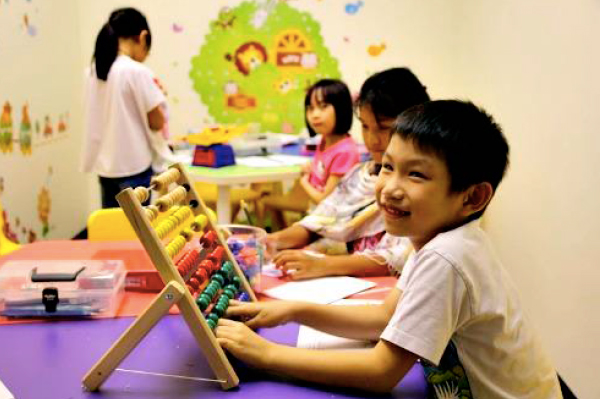
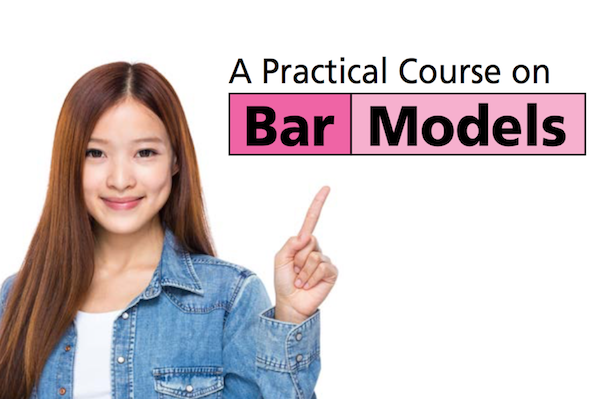
The bar model method is one of the key problem solving heuristics that students use to solve word problems in Singapore maths. It falls under the heuristic “draw a picture”.
By drawing a pictorial model of a word problem, students are able to visualise, represent and relate the known and unknown quantities in the word problem. This allows students to understand the word problem and find the solution to it. Bar models help students develop their mathematical thinking, communication, reasoning and problem-solving skills.
There are two main types of bar models, the part-whole model and the comparison model.

Word problems can be solved using variations or a combination of the two main types of bar models. Here is an overview of how bar models are used to solve word problems on different math topics.
1. Whole Number (P4)
Jimmy has 364 more cards than Tim. If Jimmy gives 210 cards to Tim, how many more cards does Tim have than Jimmy in the end?

2. Fractions (P5)
At a party, 1/2 of the adults is equal to 2/5 of the children. If there are 279 people altogether, how many children are there?

3. Decimals (P4)
2 teachers and 6 pupils visited a zoo. Each teacher paid $24.60 and each pupil paid 1/3 of the amount for the entrance fees. How much did they pay altogether?

4. Ratio (P6)
A a school concert, 1/5 of the audience was adults and the rest was children. There were 567 more children than adults. The ratio of the number of boys to the number of girls was 2:7. How many girls were there at the concert?

5. Percentage (P6)
At a Family Day event, 25% of the participants were parents. There were 84 more boys than parents who participated. The remaining 166 participants were girls. How many participants were there altogether?


Can we enhance our child’s IQ through a stimulating environment at home?
The answer is yes!
Research shows it is possible to create a highly conducive environment for cognitive and emotional growth.
A child surrounded by books and educational toys will leave positive imprint on their brain, which will follow through into their late teens.
Improving your child’s intelligence requires organising and streamlining your child’s thought process to suit and match a stimulating setting.
How can you do so? Through math and unstructured play activities.
Such experiences will help develop their fluid intelligence, sharpen their creativity and capacity to learn.
Here are more ideas on how you can create a stimulating home to boost your child’s IQ.
1. Open their world to maths through stories

A simple yet effective way to pique your child’s interest in math is picture books. Picture books are great tools to help young children learn math concepts and language. There are many great math picture books out there to read to your preschoolers. Here are recommended books for children age 4 – 6.
Counting

By Donald Crews. What can you do with ten black dots? This counting book shows your child the many unique ways that dots can make.
By Eve Merriam. This book takes readers on a counting adventure as they demonstrate twelve witty and imaginative ways to get to eleven.
Shapes

By Eric Carle. This book allows children to identify, find and match pairs together.
By Dr. Seuss. This book encourages children to ponder on shapes they may never have considered before through the whimsical rhymes and pictures of Dr. Seuss.
Patterns

By Pat Hutchins. This book has great pictures and uses humour to complement a simple storyline of a fox and hen to show readers the concept of patterning.
By Barbara Barbieri McGrath. This book uses rhyming verse and brightly coloured teddies to teach sorting and patterning.
Tip! Be expressive and use gestures while telling the story, and encourage your kids to gesture and do the actions too. Why? Studies show children are more likely to remember words, numbers and events when they gesture with their hands. Mimicking actions will also help them learn techniques such as facial recognition, anticipation, analysing and evaluating.
2. Create a construction or art corner at home

Set aside an area where your child can build, stack, draw, paint, or sculpt. You can part of their room into a craft and construction corner, well-stocked with paint, paper, blocks, clay, cardboard and other recycled materials. Let this be your child’s safe space to take apart and put together things and get all messy!
Let them have time to play or create freely, because play helps in a child’s brain development. As they draw, paint, mould and build, they are working on their imagination, creativity, and spatial skills. Spatial skills have been shown to rely on neuronal networks partially linked with mathematics.
3. Reinvent everyday objects
There is no one correct way to play. A cardboard box can be a fort to your 3-year-old. A plastic water bottle can be a rocket ship to your daughter. Finding creative uses for everyday objects allows children to be more flexible, stimulating their brain growth. It exercises their brain’s flexibility, and teaches them to engage without preconceptions.
4. Weave maths into your conversations
Demonstrate concepts of numbers such as “You have three candies, I’ll give you two more, now you’ll have five” or “Dinner will be ready in five minutes”. Not only does this train their cognitive skills, it also builds your child’s problem-solving and language skills.
According to psychologist John Protzko, kids that get early exposure to educational resources will gain higher level of IQ and give them a leg up on their peers. The idea is to have early exposure to maths and make learning fun and memorable. Having a good maths program can engage children with dialogue, probing questions, props, games and a healthy dose of encouragement.

Lineup for the quarter final of the 2018 FIFA World Cup has been decided and the World Cup Fever is at its peak. There is a lot to learn in real life from sports and it is through the watching and participation in sports, with our children, that has endless benefits for their well being and development. Research suggests that watching sports with your children can have great emotional and mental benefits too.
 Soccer is a beautiful game of skill, teamwork and strategy which captivates the attention of millions around the world. You may be surprised to know that there is lot of maths and science which goes behind every aspect of this fascinating game. We will share some such fascinating facts, so that when you are bonding with your child, rooting for your favorite team during the final stages of the tournament, you can also share some of these fascinating facts with your child.
Soccer is a beautiful game of skill, teamwork and strategy which captivates the attention of millions around the world. You may be surprised to know that there is lot of maths and science which goes behind every aspect of this fascinating game. We will share some such fascinating facts, so that when you are bonding with your child, rooting for your favorite team during the final stages of the tournament, you can also share some of these fascinating facts with your child.
 The official soccer ball (as illustrated in the above picture) is made of a combination of 12 black pentagons and 20 white hexagons. Length of each side of the pentagon and hexagon is same to ensure that they fit together like a puzzle leaving no gaps between them. In mathematical terminology this is called Tessellation. If you are interested in knowing more about the math behind the soccer ball, you can refer: http://www.hoist-point.com/soccerball.htm. If you want to engage your child in making their own football out of paper, refer the attached youtube origami craft video https://www.youtube.com/watch?v=jfHzE3TtuaI
The official soccer ball (as illustrated in the above picture) is made of a combination of 12 black pentagons and 20 white hexagons. Length of each side of the pentagon and hexagon is same to ensure that they fit together like a puzzle leaving no gaps between them. In mathematical terminology this is called Tessellation. If you are interested in knowing more about the math behind the soccer ball, you can refer: http://www.hoist-point.com/soccerball.htm. If you want to engage your child in making their own football out of paper, refer the attached youtube origami craft video https://www.youtube.com/watch?v=jfHzE3TtuaI
 Probably the most spectacular thing in soccer is seeing a player curving a soccer ball into the back of the net. Many fans almost automatically remember the Brazilian soccer player Roberto Carlos who in 1997 scored on a free kick that first went right and then curved sharply left. You would also remember the famous free kick from David Beckham, the famous England soccer player who scored on a free kick against Greece in 2001. So, how do soccer players do this? The answer lies to it in Magnus effect, a phenomenon that is commonly associated with a spinning object that drags air faster around one side, creating a difference in pressure that moves it in the direction of the lower-pressure side. A soccer ball is simply a projectile that is flying through the air with an initial velocity. The reason the ball curves is because the kicker kicks that ball at a certain angle and velocity. Once the ball is in the air, it is really the air that is curving the ball. Professional soccer players would usually kick the ball and add a little spin to it to neglect as much air resistance as possible. But in a free kick, which is usually 18 to 30 meters away from the goal, players would actually want air resistance because the air would curve and bend the ball in a way to trick the goal keeper. This all sounds easy but is extremely difficult. Players must hit the soccer ball with a precise velocity and with a particular spin. According to Bernoulli’s principles, air travels faster relative to the center of the ball where the periphery of the ball moves in the same direction as the air flow. In a normal kick, the ball would travel at roughly about 65mph. The ball would spin at around 10 revolutions per second. Once the ball travels about 10 meters, its speed would substantially drop and the drag would dramatically increase. Once the ball’s velocity drops the Magnus effect starts to increase. The Magnus effect is the reason the ball curves through the air. To know more about the magnus effect refer the Wikipedia link on the same https://en.wikipedia.org/wiki/Magnus_effect. There is a very interesting you tube video actually demonstrating the Magnus effect in football which you can also enjoy with your child https://www.youtube.com/watch?v=YIPO3W081Hw.
Probably the most spectacular thing in soccer is seeing a player curving a soccer ball into the back of the net. Many fans almost automatically remember the Brazilian soccer player Roberto Carlos who in 1997 scored on a free kick that first went right and then curved sharply left. You would also remember the famous free kick from David Beckham, the famous England soccer player who scored on a free kick against Greece in 2001. So, how do soccer players do this? The answer lies to it in Magnus effect, a phenomenon that is commonly associated with a spinning object that drags air faster around one side, creating a difference in pressure that moves it in the direction of the lower-pressure side. A soccer ball is simply a projectile that is flying through the air with an initial velocity. The reason the ball curves is because the kicker kicks that ball at a certain angle and velocity. Once the ball is in the air, it is really the air that is curving the ball. Professional soccer players would usually kick the ball and add a little spin to it to neglect as much air resistance as possible. But in a free kick, which is usually 18 to 30 meters away from the goal, players would actually want air resistance because the air would curve and bend the ball in a way to trick the goal keeper. This all sounds easy but is extremely difficult. Players must hit the soccer ball with a precise velocity and with a particular spin. According to Bernoulli’s principles, air travels faster relative to the center of the ball where the periphery of the ball moves in the same direction as the air flow. In a normal kick, the ball would travel at roughly about 65mph. The ball would spin at around 10 revolutions per second. Once the ball travels about 10 meters, its speed would substantially drop and the drag would dramatically increase. Once the ball’s velocity drops the Magnus effect starts to increase. The Magnus effect is the reason the ball curves through the air. To know more about the magnus effect refer the Wikipedia link on the same https://en.wikipedia.org/wiki/Magnus_effect. There is a very interesting you tube video actually demonstrating the Magnus effect in football which you can also enjoy with your child https://www.youtube.com/watch?v=YIPO3W081Hw.
Maths Behind the Soccer Pitch
Importance of Geometry in Strategising the Game
Knowledge of angles and measurements helps a soccer player improve his game significantly and goes behind every aspect of soccer strategizing.
 Goal keeper relies on angles to decide where he should stand when defending. In the diagram on the left in the picture below, the goalie is standing near the goal post giving the striker a wider angle to score the goal. In the diagram on the right in the picture below, the goalie has come out of the 6 yard box narrowing the angle for the striker to score the goal.
Goal keeper relies on angles to decide where he should stand when defending. In the diagram on the left in the picture below, the goalie is standing near the goal post giving the striker a wider angle to score the goal. In the diagram on the right in the picture below, the goalie has come out of the 6 yard box narrowing the angle for the striker to score the goal.So, next time you are watching this beautiful game of football, do engage your child into the fascinating maths and science behind the game.
Seriously Addictive Maths (S.A.M) is an after school math enrichment program for 3+ to 12 year olds based on teaching pedagogies of Singapore Maths, world’s best math program. If you would like to experience how we can help your child excel in maths, avail our offer of 2 weeks free trial by clicking the link http://www.seriouslyaddictivemaths.in/free_trial.php

We all are aware that mathematics is a subject that deals with study of shapes, numbers and patterns. It is an abstract subject and the approach needs to be creative to solve it. As parents, somewhere deep down inside, we all want our children to be good at mathematics; meaning good at “problem solving” and “critical thinking”. But the question that immediately springs up is “How to make our children problem solvers and critical thinkers?”
Before delving into this we should first understand what is a) problem solving and b) critical thinking and why we associate it with mathematics. The simple answer is that mathematics is all about logic and logic comes from thinking i.e. exercise of mind.
When we face obstacles and challenges while executing a task and carve out a way to deal with those difficulties, we solve a problem. This is called problem solving. There are certain attributes of a task which determines whether it is a difficult one or not.
The same can be explained through an Experiment:
Age of the sample participant : A 3 year old toddler
Skill present : Rote counting
Task : To find out sum total- addition
Level : Difficult- have never attempted addition
Experiment : First 1 yellow colored teddy bear is placed on the table and the child is asked to count. Thereafter 2 red colored teddy bears are placed on the table and the child is asked to count red ones. The toddler is then asked to find out the total number of all the teddy bears.
Execution : The toddler first looks at the bears with inquisitiveness, holds and plays with them. Thereafter places them back on the table and counts 2 reds and 1 yellow respectively. The trainer intervenes and asks probing questions like
“We see 1 yellow and 2 red teddy bears on the table but if we want to know the total number of teddy bears what shall we do?
How many teddy bears are there in all, on the table?
You counted 1 yellow teddy bear and 2 red teddy bears but if we want to know how many are there are all together what shall we do?
If we count all the teddy bears together how many they would add upto?”
The toddler once again starts counting teddy bears, slowly moves the index/pointer finger from the first teddy bear to the second one, pauses for few seconds and ponders and thereafter moves from the second teddy bear to the third one and eventually comes up with the correct answer.
Observation : Given the toddler had never counted 2 different colored manipulatives together it is posed as a challenging task. The experiment was close to introduction of addition concept. The trainer used other synonyms of the word “total” like “in all”, “together” and “add upto” to make the toddler think and understand the task.
Note : The toddler encountered with 2 different colored manipulatives for the first time and with the help of probing by the trainer could find out the total of teddy bears. The toddler was aware of the concept of rote counting and used it to find out the total. The task was ahead of the stage of learning of the toddler but by using the technique of rote counting could find out the solution.
If we conduct the above experiment with a 15 year old, it will not be problem solving scenario because the teen will not find it challenging. There would not be any struggle of thoughts to come to an answer. Also the teen would have passed this learning stage and finding total would be just an “instrumental function” of the brain now.
Also, when we develop the ability to visualise problems we are investing our time in thinking. This process of exercising our mind makes us thinkers. Thinking is a process which can be achieved only with regular practice. When we are thinking we are collating all the data in our mind, organizing it and evaluating various mathematical tools to be used for representing the same. This process is termed as “Critical Thinking”.
A problem gets solved only when we think of ways of solving it. Therefore problem solving and critical thinking is very important. It is not only crucial for mathematics but also in our day to day life. Each day unfolds with new surprises and challenges. Doing mathematics in the right way will also allow us to deal with life’s uncalled for situations and difficulties. Doing rote based learning will not make our mind prepared for the future.
Skills like a) computing fast and b) rote learning of tables and formulas, though a good skill to have, can be easily done by gadgets too. With the advancement of technology, the dependency on memory has reduced significantly and the above mentioned skills (fast computation and rote learning) constitute “Lower Order Thinking” where we are using less of human talent, i.e, our mind and treating our brain more like an instrument and performing structured tasks without much application of our mind.
Skills like
a) Reading and Understanding of a problem,
b) Filtering of relevant information and facts,
c) Visualising the facts in mind,
d) Reasoning the facts by way of analysing and evaluating the circumstances and constructing logical arguments,
e) Portraying the facts in a pictorial form,
f) Coming to the conclusion of the problem,
g) Trying out other ways to solve the same problem and
h) Expressing it verbally and in written form
constitute “Higher Order Thinking” and make our children problem solvers and critical thinkers.